Characterization and Optimization of a Conical Corona Reactor for Seed Treatment of Rapeseed
Abstract
:1. Introduction
2. Materials and Methods
2.1. Plasma Source
2.2. Discharge Characterization
2.2.1. Electrical Characterization
2.2.2. Optical Emission Spectroscopy
2.2.3. Gas Temperature
2.3. Seeds and Plasma Treatment
2.4. Seed Characterization
2.4.1. Temperature
2.4.2. Water Contact Angle
2.4.3. Germination Tests
2.5. Statistical Analysis
3. Results and Discussion
3.1. Discharge Characterization
3.2. Treatment of Rapeseed
4. Conclusions
Author Contributions
Funding
Institutional Review Board Statement
Informed Consent Statement
Data Availability Statement
Acknowledgments
Conflicts of Interest
References
- Tendero, C.; Tixier, C.; Tristant, P.; Desmaison, J.; Leprince, P. Atmospheric pressure plasmas: A review. Spectrochim. Acta Part B At. Spectrosc. 2006, 61, 2–30. [Google Scholar]
- Fridman, A.; Chirokov, A.; Gutsol, A. Non-thermal atmospheric pressure discharges. J. Phys. D Appl. Phys. 2005, 38, R1–R24. [Google Scholar]
- Ionita, E.R.; Ionita, M.D.; Stancu, E.C.; Teodorescu, M.; Dinescu, G. Small size plasma tools for material processing at atmospheric pressure. Appl. Surf. Sci. 2009, 255, 5448–5452. [Google Scholar]
- Jin, Y.; Ren, C.; Yang, L.; Zhang, J.; Wang, D. Atmospheric Pressure Plasma Jet in Ar and O2/Ar Mixtures: Properties and High Performance for Surface Cleaning. Plasma Sci. Technol. 2013, 15, 1203–1208. [Google Scholar]
- Scholtz, V.; Pazlarova, J.; Souskova, H.; Khun, J.; Julak, J. Nonthermal plasma—A tool for decontamination and disinfection. Biotechnol. Adv. 2015, 33, 1108–1119. [Google Scholar]
- Von Woedtke, T.; Reuter, S.; Masur, K.; Weltmann, K.D. Plasmas for medicine. Phys. Rep. 2013, 530, 291–320. [Google Scholar]
- Puač, N.; Gherardi, M.; Shiratani, M. Plasma agriculture: A rapidly emerging field. Plasma Processes Polym. 2018, 15, 1700174. [Google Scholar]
- Ranieri, P.; Sponsel, N.; Kizer, J.; Rojas-Pierce, M.; Hernández, R.; Gatiboni, L.; Grunden, A.; Stapelmann, K. Plasma agriculture: Review from the perspective of the plant and its ecosystem. Plasma Processes Polym. 2020, 18, 2000162. [Google Scholar]
- Attri, P.; Ishikawa, K.; Okumura, T.; Koga, K.; Shiratani, M. Plasma Agriculture from Laboratory to Farm: A Review. Processes 2020, 8, 1002. [Google Scholar]
- Go, S.-M.; Park, M.-R.; Kim, H.-S.; Choi, W.S.; Jeong, R.-D. Antifungal effect of non-thermal atmospheric plasma and its applications for control of postharvest Fusarium oxysporum decay of paprika. Food Control 2019, 98, 7. [Google Scholar]
- Ma, R.; Yu, S.; Tian, Y.; Wang, K.; Sun, C.; Li, X.; Zhang, J.; Chen, K.; Fang, J. Effect of Non-Thermal Plasma-Activated Water on Fruit Decay and Quality in Postharvest Chinese Bayberries. Food Bioprocess Technol. 2016, 9, 9. [Google Scholar]
- Seol, Y.B.; Kim, J.; Park, S.H.; Young Chang, H. Atmospheric Pressure Pulsed Plasma Induces Cell Death in Photosynthetic Organs via Intracellularly Generated ROS. Sci. Rep. 2017, 7, 589. [Google Scholar] [PubMed] [Green Version]
- Waskow, A.; Betschart, J.; Butscher, D.; Oberbossel, G.; Kloti, D.; Buttner-Mainik, A.; Adamcik, J.; von Rohr, P.R.; Schuppler, M. Characterization of Efficiency and Mechanisms of Cold Atmospheric Pressure Plasma Decontamination of Seeds for Sprout Production. Front. Microbiol. 2018, 9, 3164. [Google Scholar] [PubMed] [Green Version]
- Stryczewska, H.D.; Pawlat, J.; Ebihara, K. Non-Thermal Plasma Aided Soil Decontamination. Sci. Technol. Netw. 2013, 8, 23–30. [Google Scholar]
- Guo, Q.; Wang, Y.; Zhang, H.; Qu, G.; Wang, T.; Sun, Q.; Liang, D. Alleviation of adverse effects of drought stress on wheat seed germination using atmospheric dielectric barrier discharge plasma treatment. Sci. Rep. 2017, 7, 16680. [Google Scholar] [PubMed] [Green Version]
- Kriz, P.; Olsan, P.; Havelka, Z.; Bartos, P.; Bohata, A.; Strejckova, M.; Curn, V.; Spatenka, P. Enhancement of the Yield of Rape Seeds by Plasma Discharge and Biological Protection: Field Experiments. In Proceedings of the 2017 International Conference on Optimization of Electrical and Electronic Equipment (OPTIM) & 2017 Intl Aegean Conference on Electrical Machines and Power Electronics (ACEMP), Brasov, Romania, 25–27 May 2017. [Google Scholar]
- Liu, Z.W.; Niu, D.; Zhou, Y.X.; Cheng, J.H.; El-Din Bekhit, A.; Aadil, R.M. Oxidation induced by dielectric-barrier discharge (DBD) plasma treatment reduces soybean agglutinin activity. Food Chem. 2021, 340, 128198. [Google Scholar] [PubMed]
- Nishime, T.M.C.; Wannicke, N.; Horn, S.; Weltmann, K.-D.; Brust, H. A Coaxial Dielectric Barrier Discharge Reactor for Treatment of Winter Wheat Seeds. Appl. Sci. 2020, 10, 7133. [Google Scholar]
- Brust, H.; Nishime, T.M.C.; Wannicke, N.; Mui, T.S.M.; Horn, S.; Quade, A.; Weltmann, K.D. A medium-scale volume dielectric barrier discharge system for short-term treatment of cereal seeds indicates improved germination performance with long-term effects. J. Appl. Phys. 2021, 129, 044904. [Google Scholar]
- Šerá, B.; Vanková, R.; Roháček, K.; Šerý, M. Gliding Arc Plasma Treatment of Maize (Zea mays L.) Grains Promotes Seed Germination and Early Growth, Affecting Hormone Pools, but Not Significantly Photosynthetic Parameters. Agronomy 2021, 11, 2066. [Google Scholar]
- Shapira, Y.; Bormashenko, E.; Drori, E. Pre-germination plasma treatment of seeds does not alter cotyledon DNA structure, nor phenotype and phenology of tomato and pepper plants. Biochem. Biophys. Res. Commun. 2019, 519, 512–517. [Google Scholar] [PubMed]
- Guragain, R.P.; Baniya, H.B.; Dhungana, S.; Chhetri, G.K.; Sedhai, B.; Basnet, N.; Shakya, A.; Pandey, B.P.; Pradhan, S.P.; Joshi, U.M.; et al. Effect of plasma treatment on the seed germination and seedling growth of radish (Raphanus sativus). Plasma Sci. Technol. 2021, 24, 015502. [Google Scholar]
- Tomeková, J.; Kyzek, S.; Medvecká, V.; Gálová, E.; Zahoranová, A. Influence of Cold Atmospheric Pressure Plasma on Pea Seeds: DNA Damage of Seedlings and Optical Diagnostics of Plasma. Plasma Chem. Plasma Process. 2020, 40, 1571–1584. [Google Scholar]
- Farooq, M.A.; Ali, B.; Gill, R.A.; Islam, F.; Cui, P.; Zhou, W. Breeding Oil Crops for Sustainable Production: Heavy Metal Tolerance. In Breeding Oilseed Crops for Sustainable Production; Academic Press: Cambridge, MA, USA, 2016; pp. 19–31. [Google Scholar]
- FAO. Oilcrops, Oils and Meals. In Food Outlook—Biannual Report on Global Food Markets; FAO: Rome, Italy, 2020; pp. 29–37. [Google Scholar] [CrossRef]
- Wu, W.; Ma, B.L.; Whalen, J.K. Enhancing Rapeseed Tolerance to Heat and Drought Stresses in a Changing Climate: Perspectives for Stress Adaptation from Root System Architecture. Adv. Agron. 2018, 151, 87–157. [Google Scholar]
- Li, L.; Li, J.; Shao, H.; Dong, Y. Effects of low-vacuum helium cold plasma treatment on seed germination, plant growth and yield of oilseed rape. Plasma Sci. Technol. 2018, 20, 095502. [Google Scholar]
- Islam, S.; Omar, F.B.; Sajib, S.A.; Roy, N.C.; Reza, A.; Hasan, M.; Talukder, M.R.; Kabir, A.H. Effects of LPDBD Plasma and Plasma Activated Water on Germination and Growth in Rapeseed (Brassica napus). Gesunde Pflanz. 2019, 71, 175–185. [Google Scholar]
- Puligundla, P.; Kim, J.-W.; Mok, C. Effect of corona discharge plasma jet treatment on decontamination and sprouting of rapeseed (Brassica napus L.) seeds. Food Control 2017, 71, 376–382. [Google Scholar]
- Wannicke, N.; Wagner, R.; Stachowiak, J.; Nishime, T.M.C.; Ehlbeck, J.; Weltmann, K.D.; Brust, H. Efficiency of plasma-processed air for biological decontamination of crop seeds on the premise of unimpaired seed germination. Plasma Processes Polym. 2020, 18, 2000207. [Google Scholar]
- Ling, L.; Jiangang, L.; Minchong, S.; Chunlei, Z.; Yuanhua, D. Cold plasma treatment enhances oilseed rape seed germination under drought stress. Sci. Rep. 2015, 5, 13033. [Google Scholar]
- Mui, T.S.M.; Mota, R.P.; Quade, A.; Hein, L.R.d.O.; Kostov, K.G. Uniform surface modification of polyethylene terephthalate (PET) by atmospheric pressure plasma jet with a horn-like nozzle. Surf. Coat. Technol. 2018, 352, 338–347. [Google Scholar]
- Joosen, R.V.; Kodde, J.; Willems, L.A.; Ligterink, W.; van der Plas, L.H.; Hilhorst, H.W. GERMINATOR: A software package for high-throughput scoring and curve fitting of Arabidopsis seed germination. Plant J. 2010, 62, 148–159. [Google Scholar]
- Winter, J.; Nishime, T.M.C.; Glitsch, S.; Lühder, H.; Weltmann, K.-D. On the development of a deployable cold plasma endoscope. Contrib. Plasma Phys. 2018, 58, 404–414. [Google Scholar]
- Khamsen, N.; Onwimol, D.; Teerakawanich, N.; Dechanupaprittha, S.; Kanokbannakorn, W.; Hongesombut, K.; Srisonphan, S. Rice (Oryza sativa L.) Seed Sterilization and Germination Enhancement via Atmospheric Hybrid Nonthermal Discharge Plasma. ACS Appl. Mater. Interfaces 2016, 8, 19268–19275. [Google Scholar] [PubMed]
- Coburn, J.W.; Chen, M. Optical emission spectroscopy of reactive plasmas: A method for correlating emission intensities to reactive particle density. J. Appl. Phys. 1980, 51, 3134–3136. [Google Scholar]
- Judée, F.; Dufour, T. Seed-packed dielectric barrier device for plasma agriculture: Understanding its electrical properties through an equivalent electrical model. J. Appl. Phys. 2020, 128, 044901. [Google Scholar]
- Van Laer, K.; Bogaerts, A. Influence of Gap Size and Dielectric Constant of the Packing Material on the Plasma Behaviour in a Packed Bed DBD Reactor: A Fluid Modelling Study. Plasma Processes Polym. 2017, 14, 11. [Google Scholar]
- Van Laer, K.; Bogaerts, A. How bead size and dielectric constant affect the plasma behaviour in a packed bed plasma reactor: A modelling study. Plasma Sources Sci. Technol. 2017, 26, 085007. [Google Scholar]
- Kovalyshyn, S. The Study of Electrical Properties of Components of a Winter Rape Seed Mixture. PrzeglĄd Elektrotechniczny 2020, 1, 62–66. [Google Scholar]
- Guo, C.; Shen, Y.; Shi, F. Effect of Temperature, Light, and Storage Time on the Seed Germination of Pinus bungeana Zucc. ex Endl.: The Role of Seed-Covering Layers and Abscisic Acid Changes. Forests 2020, 11, 300. [Google Scholar]
- Morent, R.; De Geyter, N.; Desmet, T.; Dubruel, P.; Leys, C. Plasma Surface Modification of Biodegradable Polymers: A Review. Plasma Processes Polym. 2011, 8, 171–190. [Google Scholar]
- Dhayal, M.; Lee, S.-Y.; Park, S.-U. Using low-pressure plasma for Carthamus tinctorium L. seed surface modification. Vacuum 2006, 80, 499–506. [Google Scholar]
- Gomez-Ramirez, A.; Lopez-Santos, C.; Cantos, M.; Garcia, J.L.; Molina, R.; Cotrino, J.; Espinos, J.P.; Gonzalez-Elipe, A.R. Surface chemistry and germination improvement of Quinoa seeds subjected to plasma activation. Sci. Rep. 2017, 7, 5924. [Google Scholar]
- Hosseini, S.I.; Mohsenimehr, S.; Hadian, J.; Ghorbanpour, M.; Shokri, B. Physico-chemical induced modification of seed germination and early development in artichoke (Cynara scolymus L.) using low energy plasma technology. Phys. Plasmas 2018, 25, 013525. [Google Scholar]
- Li, L.; Li, J.; Shen, M.; Hou, J.; Shao, H.; Dong, Y.; Jiang, J. Improving Seed Germination and Peanut Yields by Cold Plasma Treatment. Plasma Sci. Technol. 2016, 18, 1027–1033. [Google Scholar]
- Teerakawanich, N.; Kasemsuwan, V.; Jitkajornwanich, K.; Kanokbannakorn, W.; Srisonphan, S. Microcorona Discharge-Mediated Nonthermal Atmospheric Plasma for Seed Surface Modification. Plasma Chem. Plasma Process. 2018, 38, 817–830. [Google Scholar]
- Guo, Q.; Meng, Y.; Qu, G.; Wang, T.; Yang, F.; Liang, D.; Hu, S. Improvement of wheat seed vitality by dielectric barrier discharge plasma treatment. Bioelectromagnetics 2018, 39, 120–131. [Google Scholar]
- Filatova, I.; Azharonok, V.; Kadyrov, M.; Beljavsky, V.; Sera, B.; Hruskova, I.; Spatenka, P.; Sery, M. RF and Microwave Plasma Applications for Pre-sowing caryopsis Treatments. Publ. Astron. Obs. Belgrade 2010, 89, 289–292. [Google Scholar]
- Mittler, R. ROS Are Good. Trends Plant Sci. 2017, 22, 11–19. [Google Scholar] [PubMed] [Green Version]
- Mitra, A.; Li, Y.-F.; Klämpfl, T.G.; Shimizu, T.; Jeon, J.; Morfill, G.E.; Zimmermann, J.L. Inactivation of Surface-Borne Microorganisms and Increased Germination of Seed Specimen by Cold Atmospheric Plasma. Food Bioprocess Technol. 2013, 7, 645–653. [Google Scholar]
- Bormashenko, E.; Shapira, Y.; Grynyov, R.; Whyman, G.; Bormashenko, Y.; Drori, E. Interaction of cold radiofrequency plasma with seeds of beans (Phaseolus vulgaris). J. Exp. Bot. 2015, 66, 4013–4021. [Google Scholar] [PubMed] [Green Version]

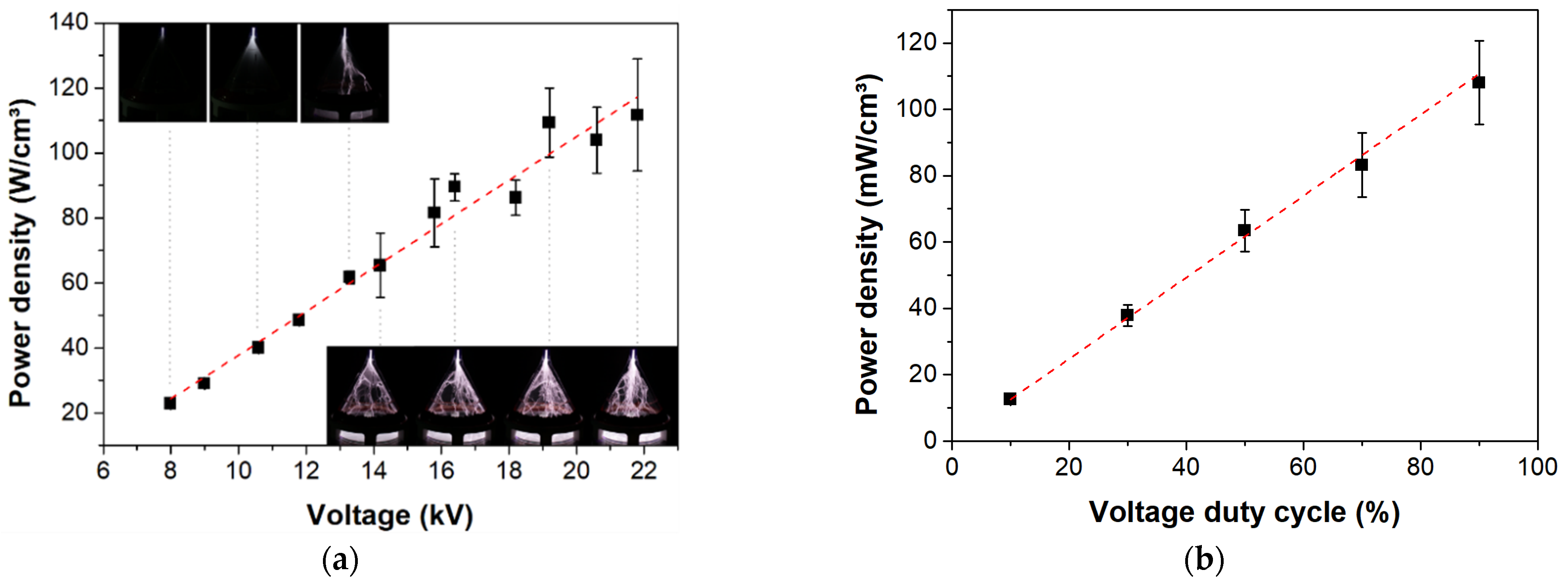

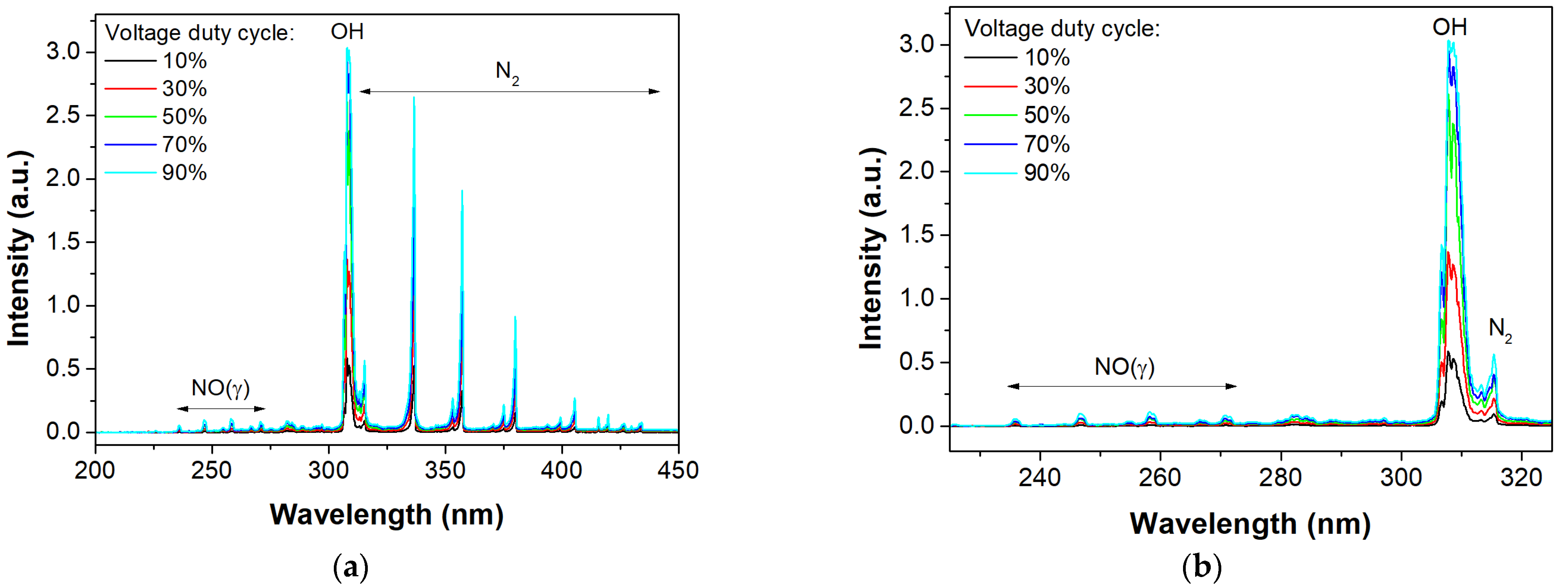

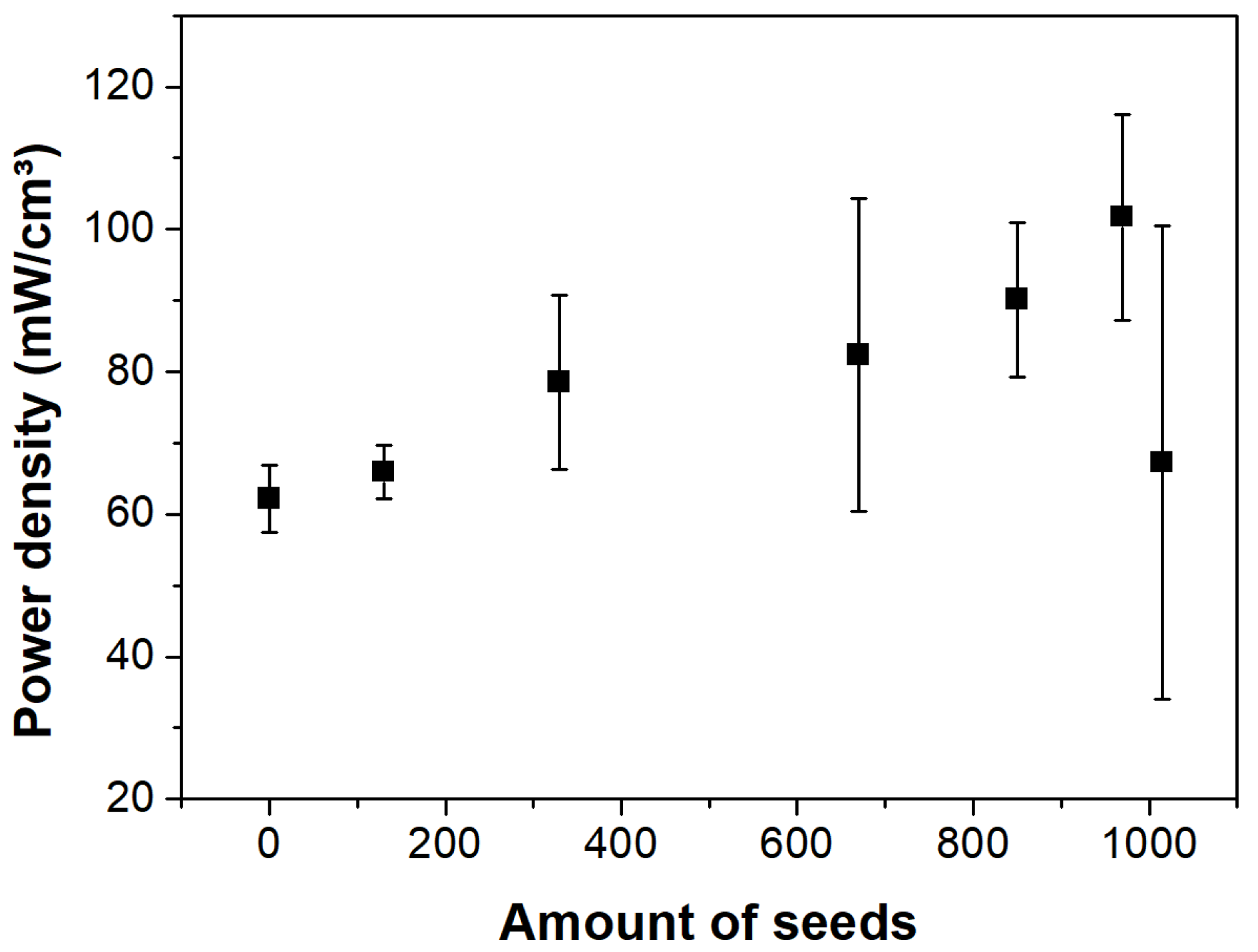
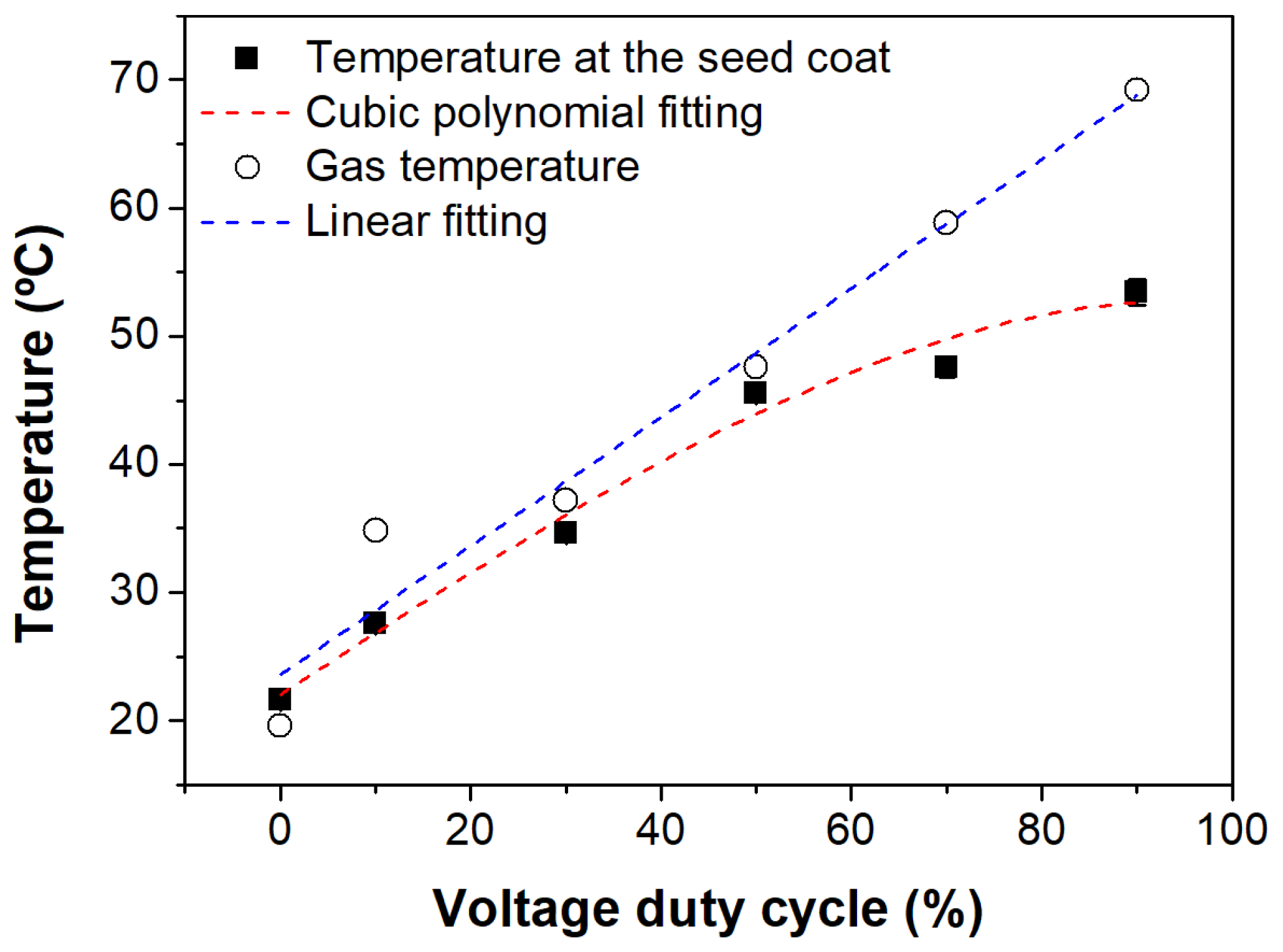
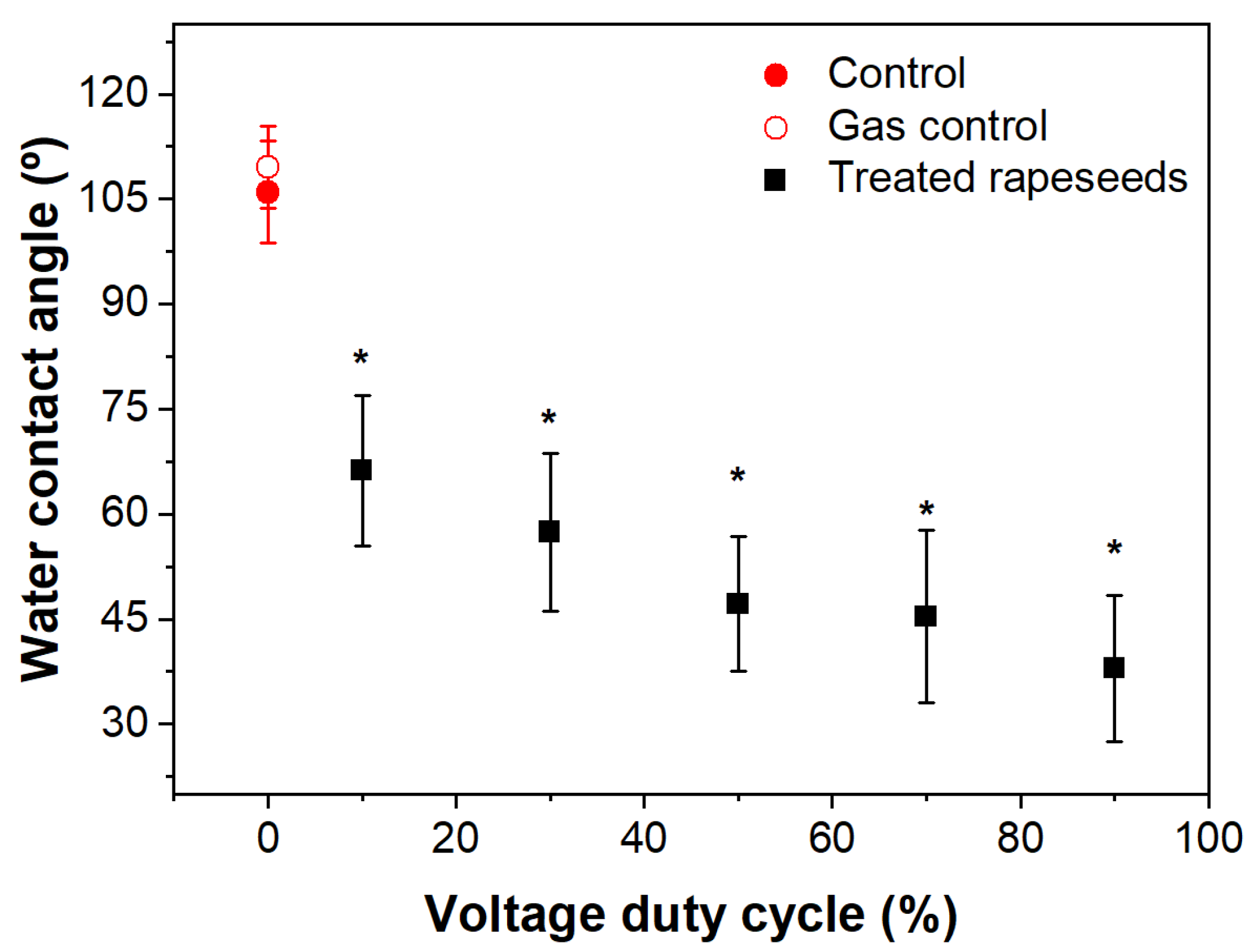

| Treatment | Gmax (%) | t50 (h) | U25–75 (h) |
|---|---|---|---|
| Ct | 92 ± 2 | 21.3 ± 0.6 | 5.8 ± 0.2 |
| Ctg | 91 ± 1 | 20.9 ± 0.7 | 4.7 ± 0.4 |
| D = 10% | 92 ± 1 | 18.6 ± 0.2 */** | 5.5 ± 0.4 |
| D = 30% | 90 ± 1 | 19.6 ± 0.5 | 5.4 ± 0.6 |
| D = 50% | 88 ± 1 | 18.6 ± 0.3 */** | 5.9 ± 0.7 |
| D = 70% | 95.6 ± 0.4 ** | 18.8 ± 0.2 */** | 6.0 ± 0.5 |
| D = 90% | 94 ± 2 | 18.0 ± 0.1 */** | 5.9 ± 0.2 ** |
Publisher’s Note: MDPI stays neutral with regard to jurisdictional claims in published maps and institutional affiliations. |
© 2022 by the authors. Licensee MDPI, Basel, Switzerland. This article is an open access article distributed under the terms and conditions of the Creative Commons Attribution (CC BY) license (https://creativecommons.org/licenses/by/4.0/).
Share and Cite
Nishime, T.M.C.; Werner, J.; Wannicke, N.; Mui, T.S.M.; Kostov, K.G.; Weltmann, K.-D.; Brust, H. Characterization and Optimization of a Conical Corona Reactor for Seed Treatment of Rapeseed. Appl. Sci. 2022, 12, 3292. https://doi.org/10.3390/app12073292
Nishime TMC, Werner J, Wannicke N, Mui TSM, Kostov KG, Weltmann K-D, Brust H. Characterization and Optimization of a Conical Corona Reactor for Seed Treatment of Rapeseed. Applied Sciences. 2022; 12(7):3292. https://doi.org/10.3390/app12073292
Chicago/Turabian StyleNishime, Thalita M. C., Jasmin Werner, Nicola Wannicke, Taiana S. M. Mui, Konstantin G. Kostov, Klaus-Dieter Weltmann, and Henrike Brust. 2022. "Characterization and Optimization of a Conical Corona Reactor for Seed Treatment of Rapeseed" Applied Sciences 12, no. 7: 3292. https://doi.org/10.3390/app12073292







